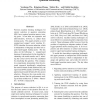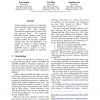117
Voted
EMNLP
2007
15 years 2 months ago
2007
This paper proposes a framework for semi-supervised structured output learning (SOL), specifically for sequence labeling, based on a hybrid generative and discriminative approach...
104
Voted
EMNLP
2007
15 years 2 months ago
2007
We demonstrate an approach for inducing a tagger for historical languages based on existing resources for their modern varieties. Tags from Present Day English source text are pro...
70
Voted
EMNLP
2007
15 years 2 months ago
2007
EMNLP
2007
15 years 2 months ago
2007
Inclusions from other languages can be a significant source of errors for monolingual parsers. We show this for English inclusions, which are sufficiently frequent to present a ...
EMNLP
2007
15 years 2 months ago
2007
Trigram language models are compressed using a Golomb coding method inspired by the original Unix spell program. Compression methods trade off space, time and accuracy (loss). The...
EMNLP
2007
15 years 2 months ago
2007
We present a comparative error analysis of the two dominant approaches in datadriven dependency parsing: global, exhaustive, graph-based models, and local, greedy, transition-base...
EMNLP
2007
15 years 2 months ago
2007
In Sequential Viterbi Models, such as HMMs, MEMMs, and Linear Chain CRFs, the type of patterns over output sequences that can be learned by the model depend directly on the model�...
95
Voted
EMNLP
2007
15 years 2 months ago
2007
In this technical report, we propose the use of Lexicalized Tree-Adjoining Grammar (LTAG) formalism as an important additional source of features for the Semantic Role Labeling (S...
116
Voted
EMNLP
2007
15 years 2 months ago
2007
We propose a sequence-alignment based method for detecting and disambiguating coordinate conjunctions. In this method, averaged perceptron learning is used to adapt the substituti...
82
Voted
EMNLP
2007
15 years 2 months ago
2007
Sentence compression holds promise for many applications ranging from summarisation to subtitle generation and subtitle generation. The task is typically performed on isolated sen...





